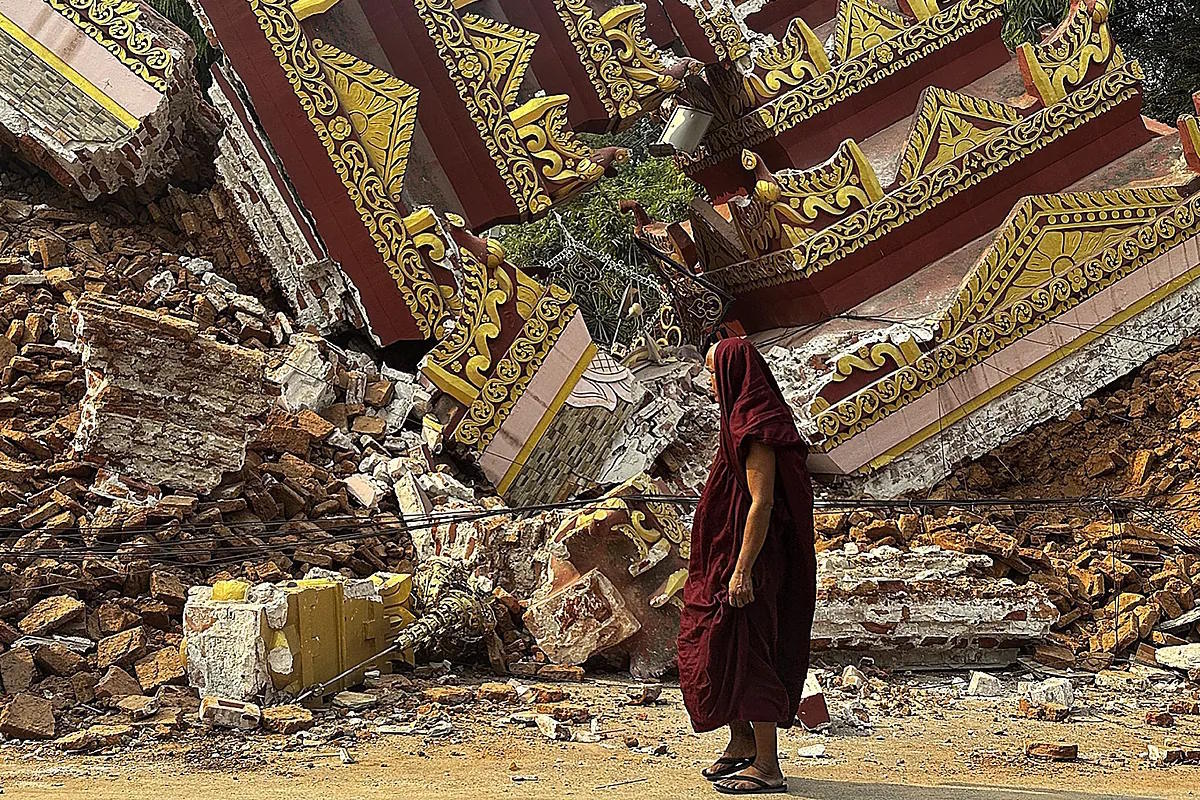Surgeon Win Soe was arrested while operating on a patient in a private clinic in Mandalay, the second-largest city in Myanmar. Five military officers, dressed in civilian clothes, stormed into the operating room, forcibly restrained the doctor, and took him away. This happened on Christmas Day 2021, 10 months after the coup. Dr. Win had participated in the massive protests in Mandalay, led by a white wave of doctors and nurses who opposed working under the military regime. "He was tortured in prison and has been in isolation for a year now, or so we have been told, because we have not been able to speak with him again," his sister Aung, also a doctor who escaped to neighboring Thailand out of fear of being detained, recounts over the phone. "Now, after the earthquake, the military should release the hundreds of imprisoned doctors to help the injured," she states.
Mandalay, home to over a million people, has been the most devastated city by an earthquake that has officially left over 1,700 dead. Hospitals are overwhelmed. "We lack many hands, medicines, food, and water," explains a young nurse, Thet, from one of the many neighborhoods destroyed by the earthquake as seen in satellite images.
"It would be very helpful to reopen all the private clinics that had to close after the raids during the protests against the regime. There are equipment and beds there. Many doctors who worked in those centers have been missing for years. If they are in prison, they should be released to help," comments another Mandalay resident via Facebook message, who prefers to remain anonymous. This woman asserts that there are still hundreds of people trapped under the rubble of various office buildings, residences, temples, mosques, and schools that collapsed.
On February 1, 2021, hours after tanks and armored vehicles surrounded the Parliament, detaining dozens of lawmakers, healthcare workers in major cities like Mandalay led the first street protests and announced a boycott of public hospitals. It was the white coat revolution, as independent Burmese media dubbed it before falling under the regime's censorship.
Tens of thousands of doctors stood up to the Military Junta for months and remained loyal to the National Unity Government, the exiled opposition formed by politicians from the party that had won the late 2020 elections, a result never accepted by the military. "In many areas, over 70% of healthcare workers have left their jobs, hospitals, and patients. It was a difficult ethical decision but necessary to make the generals who now rule return power to the people," read a note signed by several Burmese doctors published in the medical journal The Lancet.
As the civil war spread across many regions of the country, with fierce battles between the military, pro-democracy groups, and local militias, rebel doctors began setting up a healthcare system outside the Junta's control, with mobile units traveling everywhere to treat the wounded and clandestine clinics located inside temples. This lasted until security forces intensified mass arrests campaigns against healthcare workers.
The civil disobedience movement, one of the first groups formed by rebels, indicated in 2022 that around 900 healthcare workers had been arrested. "There are doctors sentenced to prison terms ranging from three to 25 years. Many others have been tortured, and at least five have been killed during their imprisonment," states a report from this collective.
In addition to the doctors in prison, many others fled the country. Some, like Aung, the sister of the missing Dr. Win, who worked as a pediatrician in Mandalay, settled in the border town of Mae Sot. "I would like to return to help the wounded, but the earthquake area is controlled by the Military Junta, and they would arrest me," she says.
The current shortage of healthcare workers is compounded by the urgent need for more rescue teams despite the arrival on Saturday of personnel from China, Russia, Malaysia, India, or Singapore. Rescue operations are also facing challenges. The military continues to launch airstrikes on areas controlled by rebel militias, and the delivery of aid is constantly hindered by damage to highways connecting the three major cities, such as the commercial center, Yangon, with Mandalay and the newly built capital, Naypyitaw, the military government's headquarters.
"Cracks and deformations on the surface forced many aid convoys to suspend their operations," notes a report from the United Nations Office for the Coordination of Humanitarian Affairs. The agency emphasizes a severe shortage of medical supplies, including blood bags and anesthetics. "Up to 20 million people live in the severely affected earthquake areas, many of whom are now without shelter or access to clean water."
This Monday, the desperate search for survivors enters its fourth day in the areas of Myanmar most affected by the major earthquake. Pro-democracy groups denounce that the Military Junta first sent international brigades to Naypyitaw instead of quickly redirecting all aid to the hardest-hit areas of Mandalay and its surroundings.
Last night, thousands of Mandalay residents and those from nearby municipalities continued to sleep on the streets due to damage to their homes or fears of new aftershocks. Several new tremors occurred on Sunday morning, causing some scenes of panic. In addition to fear, communications barely function a few hours a day, with very unstable phone and internet networks, and electricity services are constantly interrupted. In many affected areas of the city, where heavy machinery has not yet arrived, local rescue teams are clearing debris by hand and shovels under scorching heat, with temperatures reaching 41 degrees on Sunday.
